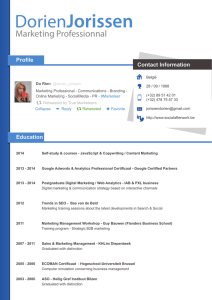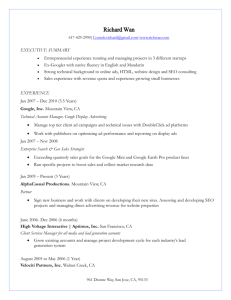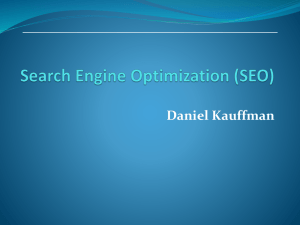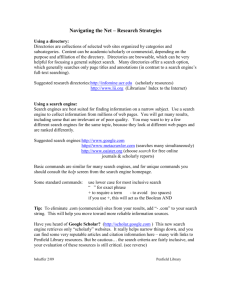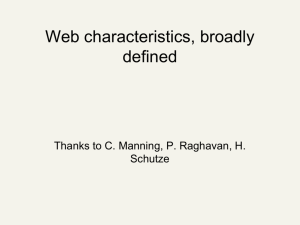View SEO Article in Printable Word Format
advertisement
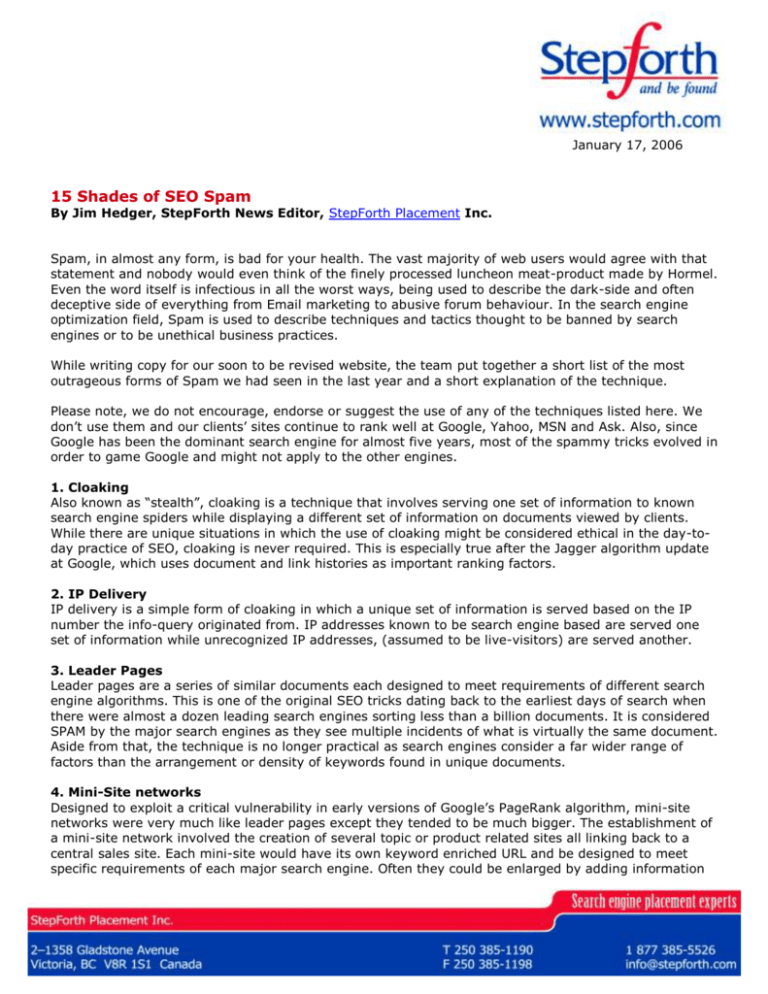
January 17, 2006 15 Shades of SEO Spam By Jim Hedger, StepForth News Editor, StepForth Placement Inc. Spam, in almost any form, is bad for your health. The vast majority of web users would agree with that statement and nobody would even think of the finely processed luncheon meat-product made by Hormel. Even the word itself is infectious in all the worst ways, being used to describe the dark-side and often deceptive side of everything from Email marketing to abusive forum behaviour. In the search engine optimization field, Spam is used to describe techniques and tactics thought to be banned by search engines or to be unethical business practices. While writing copy for our soon to be revised website, the team put together a short list of the most outrageous forms of Spam we had seen in the last year and a short explanation of the technique. Please note, we do not encourage, endorse or suggest the use of any of the techniques listed here. We don’t use them and our clients’ sites continue to rank well at Google, Yahoo, MSN and Ask. Also, since Google has been the dominant search engine for almost five years, most of the spammy tricks evolved in order to game Google and might not apply to the other engines. 1. Cloaking Also known as “stealth”, cloaking is a technique that involves serving one set of information to known search engine spiders while displaying a different set of information on documents viewed by clients. While there are unique situations in which the use of cloaking might be considered ethical in the day-today practice of SEO, cloaking is never required. This is especially true after the Jagger algorithm update at Google, which uses document and link histories as important ranking factors. 2. IP Delivery IP delivery is a simple form of cloaking in which a unique set of information is served based on the IP number the info-query originated from. IP addresses known to be search engine based are served one set of information while unrecognized IP addresses, (assumed to be live-visitors) are served another. 3. Leader Pages Leader pages are a series of similar documents each designed to meet requirements of different search engine algorithms. This is one of the original SEO tricks dating back to the earliest days of search when there were almost a dozen leading search engines sorting less than a billion documents. It is considered SPAM by the major search engines as they see multiple incidents of what is virtually the same document. Aside from that, the technique is no longer practical as search engines consider a far wider range of factors than the arrangement or density of keywords found in unique documents. 4. Mini-Site networks Designed to exploit a critical vulnerability in early versions of Google’s PageRank algorithm, mini-site networks were very much like leader pages except they tended to be much bigger. The establishment of a mini-site network involved the creation of several topic or product related sites all linking back to a central sales site. Each mini-site would have its own keyword enriched URL and be designed to meet specific requirements of each major search engine. Often they could be enlarged by adding information from leader pages. By weaving webs of links between mini-sites, an artificial link-density was created that could heavily influence Google’s perception of the importance of the main site. In the summer of 2004, Google penalized several prominent SEO and SEM firms for using this technique by banning their entire client lists. 5. Link Farms Link farms emerged as free-for-all link depositories when webmasters learned how heavily incoming links influenced Google. Google, in turn, quickly devalued and eventually eliminated the PR value it assigned to pages with an inordinate collection or number of links. Nevertheless, link farms persist as uninformed webmasters and unethical SEO firms continue to use them. 6. Blog and/or Forum Spam Blogs and forums are amazing and essential communication technologies, both of which are used heavily in the daily conduct of our business. As with other Internet based media, blogs and forum posts are easily and often proliferated. In some cases, blogs and certain forums also have established high PR values for their documents. These two factors make them targets of unethical SEOs looking for high-PR links back to their websites or those of their clients. Google in particular has clamped down on Blog and Forum abuse. 7. Keyword Stuffing At one time, search engines were limited to sorting and ranking sites based on the number of keywords found on those documents. That limitation led webmasters to put keywords everywhere they possibly could. When Google emerged and incoming links became a factor, some even went as far as using keyword stuffing of anchor text. The most common continuing example of keyword stuffing can be found near the bottom of far too many sites in circulation. 8. Hidden Text It is amazing that some webmasters and SEOs continue to use hidden text as a technique but, as evidenced by the number of sites we find it on, a lot of folks still use it. They shouldn’t. There are two types of hidden text. The first is text that is coloured the same shade as the background thus rendering it invisible to human visitors but not to search spiders. The second is text that is hidden behind images or under document layers. Search engines tend to dislike both forms and have been known to devalue documents containing incidents of hidden text. 9. Useless Meta Tags Most meta tags are absolutely useless. The unethical part is that some SEO firms actually charge for the creation and insertion of meta tags. In some cases, there seems to be a meta tag for virtually every possible factor but for the most part are not considered by search spiders. StepForth only uses the description and keywords meta tags (though we are dubious about the actual value of the keywords tag), along with relevant robots.txt files. All other identifying or clarifying information should be visible on a contact page or included in the footers of each page. 10. Misuse of Directories Directories, unlike other search indexes, tend to be sorted by human hands. Search engines traditionally gave links from directories a bit of extra weight by considering them links from trusted authorities. A practice of spamming directories emerged as some SEOs and webmasters hunted for valuable links to improve their rankings. Search engines have since tended to devalue links from most directories. Some SEOs continue to charge directory submission fees. 11. Hidden Tags There are a number of different sorts of tags used by search browsers or website designers to perform a variety of functions such as; comment tags, style tags, alt tags, noframes tags, and http-equiv tags. For example, the “alt tag” is used by site-readers for the blind to describe visual images. Inserting keywords into these tags was a technique used by a number SEOs in previous years. Though some continue to improperly use these tags, the practice overall appears to be receding. 12. Organic Site Submissions One of the most unethical things a service-based business can do is to charge clients for a service they don’t really need. Charging for, or even claiming submissions to the major search engines are an example. Search engine spiders are so advanced they no longer require site submission to find information. Search engine spiders find new documents by following links. Site submission services or SEO firms that charge clients a single penny for submission to Google, Yahoo, MSN or Ask Jeeves, are radically and unethically overcharging those clients. 13. Email Spam Placing a URL inside a “call-to-action” email continues to be a widely used of search marketing spam. With the advent of desktop search appliances, email spam has actually increased. StepForth does not use email to promote your website in any way. 14. Redirect Spam There are several ways to use the redirect function to fool a search engine or even hijack traffic destined for another website! Whether the method used is a 301, a 302, a 402, a meta refresh or a java-script, the end result is search engine spam. 15. Misuse of Web 2.0 Formats (ie Wiki, social networking and social tagging) An emerging form of SEO spam is found in the misuse of user-input media formats such as Wikipedia. Like blog comment spamming, the instant live-to-web nature of Web 2.0 formats provide an open range for SEO spam technicians. Many of these exploits might even find short-term success though it is only a matter of time before measures are taken to devalue the efforts. Search engine optimization spam continues to be a problem for the SEO industry as it tries to move past the perceptions of mainstream advertisers. When under-ethical techniques are used, trust (the basis of all business) is abused and the efforts of the SEO/SEM industry are called into question. Fortunately, Google’s new algorithm appears to be on the cutting edge of SEO Spam detection and prevention. Let’s hope 2006 is the year the entire SEO industry goes on a Spam-free diet.
